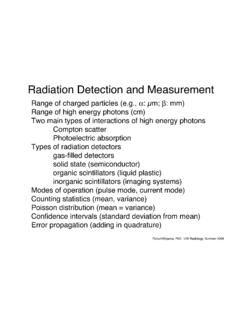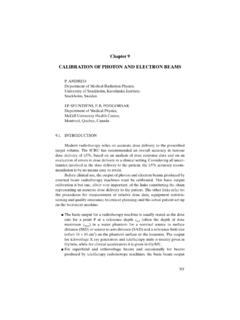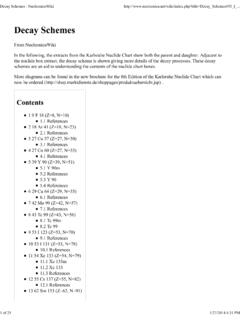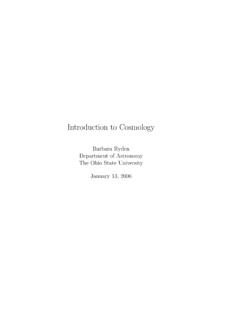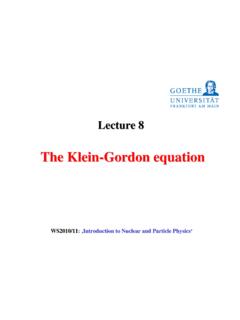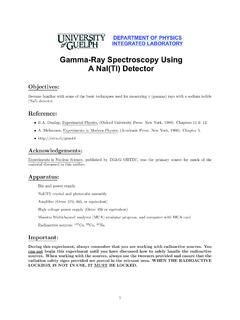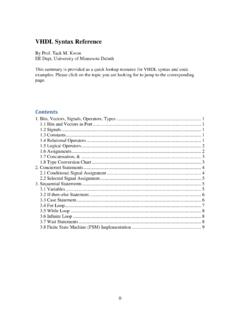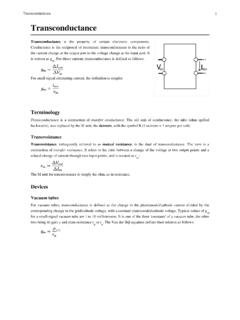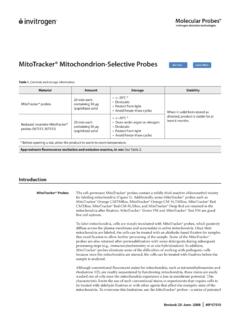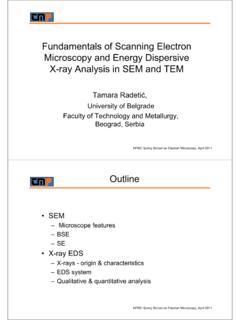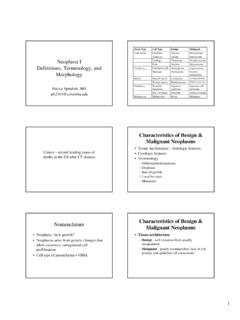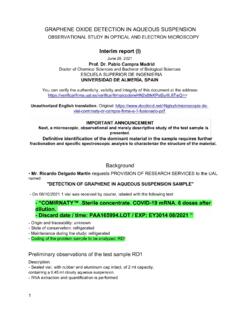Transcription of Förster resonance energy transfer
1 F rster resonance energy transfer1F rster resonance energy transferJablonski diagram of FRET with typicaltimescales rster ( fluorescence ) resonance energy transfer (FRET), resonance energy transfer (RET) or electronic energy transfer (EET), is a mechanism describing energy transfer between twochromophores.[1] A donor chromophore, initially in its electronicexcited state, may transfer energy to an acceptor chromophore throughnonradiative dipole dipole coupling.[2] The efficiency of this energytransfer is inversely proportional to the sixth power of the distancebetween donor and acceptor making FRET extremely sensitive to smalldistances.
2 [3]Measurements of FRET efficiency can be used to determine if twofluorophores are within a certain distance of each other.[4] Suchmeasurements are used as a research tool in fields including biologyand is analogous to near field communication, in that the radius of interaction is much smaller than the wavelengthof light emitted. In the near field region, the excited chromophore emits a virtual photon that is instantly absorbed bya receiving chromophore. These virtual photons are undetectable, since their existence violates the conservation ofenergy and momentum, and hence FRET is known as a radiationless mechanism.
3 Quantum electrodynamicalcalculations have been used to determine that radiationless (FRET) and radiative energy transfer are the short- andlong-range asymptotes of a single unified mechanism.[5][6]TerminologyF rster resonance energy transfer is named after the German scientist Theodor F rster.[7] When both chromophoresare fluorescent, the term " fluorescence resonance energy transfer " is often used instead, although the energy is notactually transferred by fluorescence .[8][9] In order to avoid an erroneous interpretation of the phenomenon that isalways a nonradiative transfer of energy (even when occurring between two fluorescent chromophores), the name"F rster resonance energy transfer " is preferred to " fluorescence resonance energy transfer ;" however, the latterenjoys common usage in scientific literature.
4 [10]Theoretical basisThe FRET efficiency ( ) is the quantum yield of the energy transfer transition, the fraction of energy transferevent occurring per donor excitation event[11]:where is the rate of energy transfer , the radiative decay rate, and the 's are the rate constants of anyother de-excitation pathways.[12]The FRET efficiency depends on many physical parameters that can be grouped as follows: The distance between the donor and the acceptor The spectral overlap of the donor emission spectrum and the acceptor absorption spectrum. The relative orientation of the donor emission dipole moment and the acceptor absorption dipole on the donor-to-acceptor separation distance with an inverse 6th power law due to the dipole-dipolecoupling mechanism:F rster resonance energy transfer2with being the F rster distance of this pair of donor and acceptor, the distance at which the energy transferefficiency is 50%.
5 [12] The F rster distance depends on the overlap integral of the donor emission spectrum with theacceptor absorption spectrum and their mutual molecular orientation as expressed by the following equation.[13][14]where is the fluorescence quantum yield of the donor in the absence of the acceptor, 2 is the dipole orientationfactor, is the refractive index of the medium, is Avogadro's number, and is the spectral overlap integralcalculated aswhere is the normalized donor emission spectrum, and is the acceptor molar extinction coefficient.[15] 2=2/3 is often assumed.
6 This value is obtained when both dyes are freely rotating and can be considered to beisotropically oriented during the excited state lifetime. If either dye is fixed or not free to rotate, then 2 =2/3 will notbe a valid assumption. In most cases, however, even modest reorientation of the dyes results in enough orientationalaveraging that 2 = 2/3 does not result in a large error in the estimated energy transfer distance due to the sixth powerdependence of R0 on 2. Even when 2 is quite different from 2/3 the error can be associated with a shift in R0 andthus determinations of changes in relative distance for a particular system are still valid.
7 Fluorescent proteins do notreorient on a timescale that is faster than their fluorescence lifetime. In this case 0 2 4.[15]The FRET efficiency relates to the quantum yield and the fluorescence lifetime of the donor molecule as follows:[16]where and are the donor fluorescence lifetimes in the presence and absence of an acceptor, respectively, oraswhere and are the donor fluorescence intensities with and without an acceptor, rster resonance energy transfer3 Experimental Confirmation of the F rster resonance energy transfer theoryThe inverse sixth power distance dependence of F rster resonance energy transfer was experimentally confirmed byStryer and Haugland[17] using a donor and an acceptor separated on an oligoproline helix.
8 Haugland, Yguerabide andStryer[18] also experimentally demonstrated the theoretical dependence of F rster resonance energy transfer on theoverlap integral by using a fused indolosteroid as a donor and a ketone as an to measure FRET efficiencyExample of FRET between CFP and YFP(Wavelength vs. Absorption): a fusion proteincontaining CFP and YFP excited at 440nmwavelength. The fluorescent emission peak ofCFP overlaps the excitation peak of the two proteins are adjacent to eachother, the energy transfer is significant a largeproportion of the energy from CFP is transferredto YFP and creates a much larger YFP fluorescence microscopy , fluorescence confocal laser scanningmicroscopy, as well as in molecular biology, FRET is a useful tool toquantify molecular dynamics in biophysics and biochemistry, such asprotein-protein interactions, protein DNA interactions.
9 And proteinconformational changes. For monitoring the complex formationbetween two molecules, one of them is labeled with a donor and theother with an acceptor. The FRET efficiency is measured and used toidentify interactions between the labeled complexes. There are severalways of measuring the FRET efficiency by monitoring changes in thefluorescence emitted by the donor or the acceptor.[19]Sensitized emissionOne method of measuring FRET efficiency is to measure the variationin acceptor emission intensity.[14] When the donor and acceptor are inproximity (1 10 nm) due to the interaction of the two molecules, theacceptor emission will increase because of the intermolecular FRET from the donor to the acceptor.
10 For monitoring protein conformationalchanges, the target protein is labeled with a donor and an acceptor attwo loci. When a twist or bend of the protein brings the change in thedistance or relative orientation of the donor and acceptor, FRET change is observed. If a molecular interaction or a proteinconformational change is dependent on ligand binding, this FRET technique is applicable to fluorescent indicators for the FRETFRET efficiencies can also be inferred from the photobleaching rates of the donor in the presence and absence of anacceptor.
